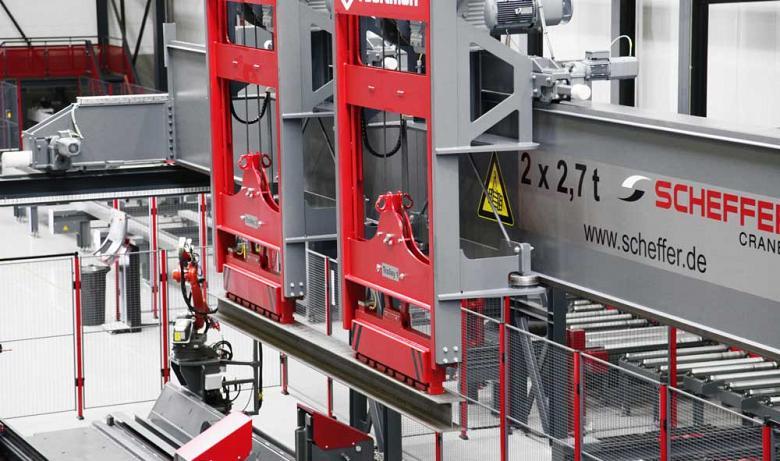- FMA
- The Fabricator
- FABTECH
- Canadian Metalworking
Categories
- Additive Manufacturing
- Aluminum Welding
- Arc Welding
- Assembly and Joining
- Automation and Robotics
- Bending and Forming
- Consumables
- Cutting and Weld Prep
- Electric Vehicles
- En Español
- Finishing
- Hydroforming
- Laser Cutting
- Laser Welding
- Machining
- Manufacturing Software
- Materials Handling
- Metals/Materials
- Oxyfuel Cutting
- Plasma Cutting
- Power Tools
- Punching and Other Holemaking
- Roll Forming
- Safety
- Sawing
- Shearing
- Shop Management
- Testing and Measuring
- Tube and Pipe Fabrication
- Tube and Pipe Production
- Waterjet Cutting
Industry Directory
Webcasts
Podcasts
FAB 40
Advertise
Subscribe
Account Login
Search
Top 5 in 365—Articles about automation and robotics
- By Vicki Bell
- June 21, 2018

A material handling system picks up the workpiece after it exits the beam line and positions it for automated welding
The previous installment of Top 5 in 365 focused on assembly and joining, a key component of many fabrication operations and applications. These tasks and any others can be performed with automation and robotics. Here are the top articles published within the last year on thefabricator.com in the “Automation and Robotics” category. Note that four focus on robotic welding, which makes sense when you considered the much-touted shortage of skilled welders. And one touches on the sensitive topic of introducing robotic welding in the workplace where workers are worried about losing their jobs.
5. Tips for successful robotic aluminum welding
Process considerations for lightweighting
While welding steel is routine, a growing number of companies, especially truck trailer manufacturers, are transitioning to the use of aluminum parts to meet customer demands for more efficient, lightweight vehicles. Finding success with robotic aluminum welding requires special considerations to maintain the welding operation.
4. Automated fitting and welding becomes reality in structural steel fabrication
Prospect Steel achieves new levels of productivity with recent capital equipment investment
Some might argue that the domestic construction industry has never recovered from the Great Recession. Many shops have held on since then, but they aren’t prospering like they were prior to 2009. Prospect Steel, Little Rock, Ark., was in that position—at least until recently. It’s taken the leap into automated fitting and welding, and the robotic investment has reshaped the structural steel fabricator’s future.
3. Welding automation gets heavy
Accounting for process variation is key
Implementing well-thought-out automation boils down to two steps. First, design out all the variation you can, through smart part and fixture design. Second, use available tools, like seam tracking and adaptive fill, to account for the variation that remains.
2. How welding robots affect shop culture
It’s a subtle, complex issue, but the net result should be positive
Bring in a welding robot, and people think their job is at risk. It’s an old story, and perhaps not quite as common today, but bringing in a welding robot still has a cultural impact. If done right, though, the net result should be positive.
1. A brief history of structural fabrication technology: The road to full automation
How structural fabrication evolved from the 1970s to now
Structural fabrication has evolved from a largely manual operation to one in which virtually every manufacturing step can be fully automated. Few if any metal manufacturing sectors can make such a claim.
Next up? Consumables.
subscribe now

The Fabricator is North America's leading magazine for the metal forming and fabricating industry. The magazine delivers the news, technical articles, and case histories that enable fabricators to do their jobs more efficiently. The Fabricator has served the industry since 1970.
start your free subscriptionAbout the Author

Vicki Bell
2135 Point Blvd
Elgin, IL 60123
815-227-8209
- Stay connected from anywhere

Easily access valuable industry resources now with full access to the digital edition of The Fabricator.

Easily access valuable industry resources now with full access to the digital edition of The Welder.

Easily access valuable industry resources now with full access to the digital edition of The Tube and Pipe Journal.
- Podcasting
- Podcast:
- The Fabricator Podcast
- Published:
- 04/16/2024
- Running Time:
- 63:29
In this episode of The Fabricator Podcast, Caleb Chamberlain, co-founder and CEO of OSH Cut, discusses his company’s...
- Trending Articles
Tips for creating sheet metal tubes with perforations

Are two heads better than one in fiber laser cutting?

Supporting the metal fabricating industry through FMA

JM Steel triples capacity for solar energy projects at Pennsylvania facility

Omco Solar opens second Alabama manufacturing facility

- Industry Events
16th Annual Safety Conference
- April 30 - May 1, 2024
- Elgin,
Pipe and Tube Conference
- May 21 - 22, 2024
- Omaha, NE
World-Class Roll Forming Workshop
- June 5 - 6, 2024
- Louisville, KY
Advanced Laser Application Workshop
- June 25 - 27, 2024
- Novi, MI


























